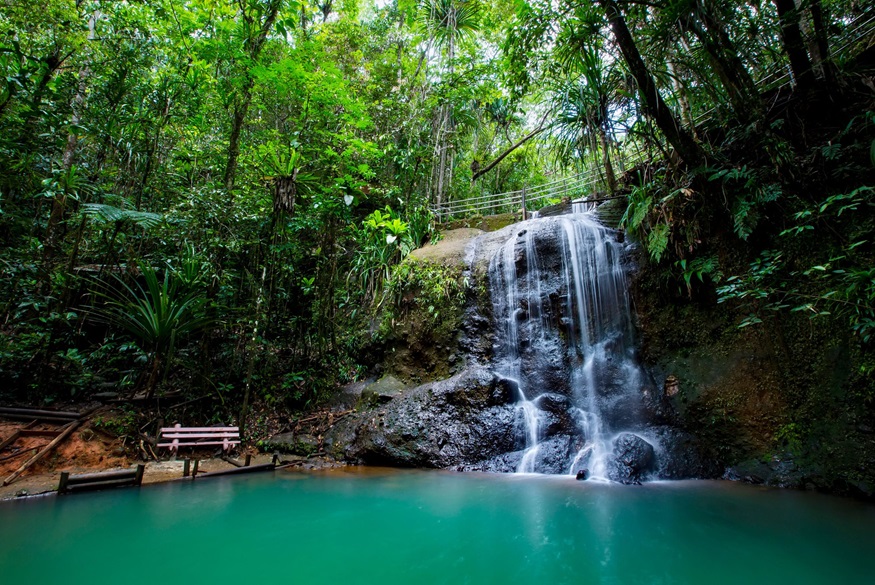Located just a 20-minute drive away from Suva’s central business district is the lush and vibrant oasis of the Colo-i-Suva Forest Park and Reserve.
Locals and tourists looking to escape the hustle and bustle of the city or just simply let loose and spend time with friends and family are regular patrons of the forest park with an even larger number of visitors flocking there during the school and public holidays.
The Sunday Times team visited Colo-i-Suva Forest Park and Reserve earlier this week and even though it was a work-related trip, the visit was as if we had stepped into an entirely different world.
The serenity and tranquillity of walking through towering mahogany trees and listening to the cries of exotic birds can put even the most restless mind at ease.
The park and reserve were established in 1952 and sitting at an elevation of 56 metres, it is located just on the outskirts of the Colo-i-Suva village and is accessible by all forms of transportation.
It is managed by the Ministry of Forestry. Visitors can catch a bus from the Suva bus station which will cost under $2 and take approximately 30 minutes one way or by taxi which can usually cost up to $15.
However, if driving, follow Princes Rd through Tamavua and Tacirua village. The main entrance to the park is located right opposite the Ministry of Forestry station and Colo-i-Suva Rainforest Eco Lodge.
The forest park is a 4.97 square kilometre sanctuary that is home to a plethora of flora and fauna that is endemic to Fiji.
Historical data from the Ministry of Forestry showed that African Mahogany trees were planted after a period of aggressive logging in the 1940s and ’50s to stabilise the topsoil without impinging on the indigenous vegetation.
Scientific data from the ministry also stated that the lush exotic trees within the Forest Park were vital for purifying and filtering air and water, preventing soil erosion, and in mitigating the impacts of climate change.
According to the Commonwealth Forestry Association, of the 50 per cent of Fiji’s endemic plants, 45 per cent can be found thriving in the forests of Colo-i-Suva.
Flowers in full bloom include bamboo orchids, white ginger, morning glory, and sunset bell. Flourishing all along the forest trails are endemic ferns such as the false staghorn, birds nest fern, and king fern.
The association also stated that of the 57 land birds found in Fiji, 30 can be found in Colo-i-Suva, the cries and calls of most can be heard overhead in the towering trees.
The most notable sound one would hear would be from the Barking Imperial Pigeon known locally as the Soqe.
Found close to the many creeks and pools is the Pacific Kingfisher. Exotic birds that feast on the numerous fruiting trees range from the Fiji Whistler, the Shrikebill, Woodswallow, and Parrotfinches.
Migratory birds like the Pacific black duck and white-faced heron together with predatory birds such as the Fiji goshawk and swamp harrier can also be found in the reserve area.
The sanctuary also teems with insect and reptilian life. More than 20 species of butterflies like the Fijian ringlet and great eggfly help in pollinating blooming flowers. Spiders, dragonflies, and moths are in abundance, as well as crawlies like slugs, snails, caterpillars, and millipedes of varying lengths and colours.
Nestled among the lush towering trees is the Pacific Flying Fox, which indulges on the numerous fruit trees within the forest park and reserve area and if you do hear an occasional hissing and shrieking sound, that would be from the Small Indian Mongoose.
As a picnic and recreational retreat, Colo-i-Suva offers some of the most spectacular forest trails for enthusiastic hikers, as well as rock pools and waterfalls for those looking to cool off and relax.
Temperatures around and within the reserve area occasionally drop to as low as 15 to 20 degrees and it tends to rain or drizzle for three to four days a week, making it wetter than most parts of Suva.
The Waisiliva Creek is the predominant waterway that slips and slides through the forest over water-worn rocks, forming dozens of water swimming holes as it makes its way down from the Waimanu River.
There are two car parks at the entrance, one leads to the upper pools while the other leads to the lower pools.
The largest and most famous of the two waterfalls in the forest park is the Waisila Falls with its ever-popular rope swing.
The pool here is deep enough for swimming and even diving.
Tables and bure sheds close to the water’s edge provide a safe and dry place to enjoy a meal or just simply kick back and enjoy a short nap.
Forest reserves are a critical component for the health and well-being of any flourishing ecosystem.
Here in Fiji, they are a source of fuel, water, nourishment, and oxygen, a vital stabiliser for the climate, and a protector of biodiversity.
The importance of the Colo-i-Suva Forest Park and Reserve as a haven and natural oasis for several of Fiji’s endemic plant and animal species was internationally recognised when it was registered under the Queen’s Commonwealth Canopy by Her Majesty the late Queen Elizabeth II during the Commonwealth Heads of Government meeting held in Malta in 2015.
The Ministry of Forestry stated that in late October 2018, during the Duke and Duchess of Sussex’s visit to Fiji, Prince Harry visited Colo-i-Suva and planted a Fijian Kauri tree known locally as Dakua Makadre, which the ministry maintains to this day.
The next time you decide to visit the forest park or if you have not and decide to schedule a visit, apart from the usual hiking and swimming, do take the opportunity to observe and appreciate the various lifeforms, ranging from plants to birds and insects.
It is never a dull moment at Colo-i-Suva and there is always something new to see.



